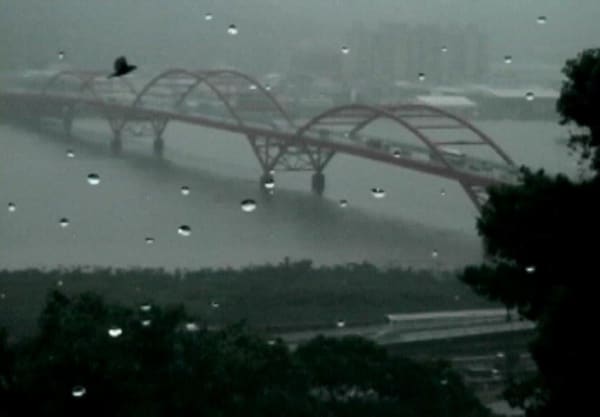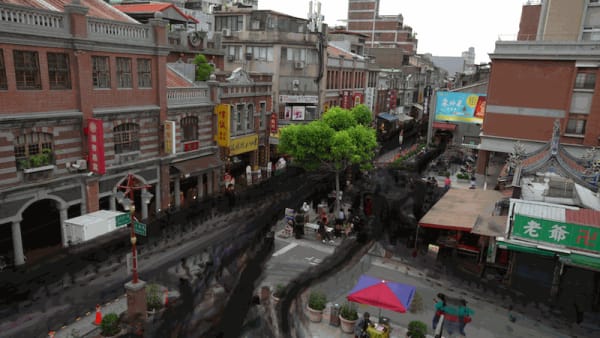"Seeing Through Light"
Curated by Jason Wang
Venue: TAO Art Space, Taipei
Exhibition Period: 13 July - 12 October 2021
Once during nightfall, sculptor Auguste Rodin (1840-1917) held a lamp and led art critic Paul Gsell (1870-1947) to see an ancient Greek statue of Venus in the dark. With the dim lamplight, the sculptor turned the movable platform that held the statue, and made the critic look closely at the torso of Venus, illuminating the complex and intricate projections and depressions. This way, Rodin helped Gsell to discover the beauty of flesh represented by artists in the Classical period.[1]
During his youth, Wu Chi-Tsung was still exploring creative possibilities, and had also seen himself through light. In the dark, he replaced paintbrush with a flashlight, and pointed it at his face to capture his own portrait, while also setting the camera on long exposure (B mode) to allow the trail of light to simultaneously develop on the film. The printed and enlarged images became his earliest “Self-Portrait” series (2004). Based on this, “seeing through light” is not just a metaphor of Wu Chi-Tsung’s personal enlightenment and self-discovery, but also his unique creative means.
Before the “Self-Portrait” series, he tried to capture the scenery outside his home window using high shutter speed (1/8000 second) for “Rain” (2002). In the video, the constantly skipping raindrops are a sharp comparison to the seemingly stationary landscape of the Tamsui River far away, especially the Guandu Bridge that spans over the river, as well as the roads and surrounding woods. Between those things moving at a high speed and remaining stationary are the endless traffic on the bridge and the road. Through camera and video camera, Wu Chi-Tsung repeatedly reverses and topples human’s daily vision, as well as their perceptive experience of reality. Consciously, Wu Chi-Tsung manipulates the “moment” in time by stretching and slowing it down or rapidly accelerating and speeding it up, through which he offers an alternative way of looking at reality.
“Seeing through light” is a common term in Buddhist scriptures, referring to the thorough understanding and transcendence of enlightenment. In May 2021, Wu Chi-Tsung holds a solo exhibition at TAO ART Space. In response to the gallery’s collection of classical sculptures, Wu has specially selected five Buddhist statues from different dynasties that have unique aesthetics and spiritual significances, including: “Gilded and Colored Limestone Head of Buddha” from Eastern Wei to Northern Qi (6th century), “Limestone Head of Buddha” and “Limestone Standing Bodhisattva” from Northern Qi (6th century), “Limestone Head of Bodhisattva” from Sui (6th-7th century), and “Wooden Standing Venerable Ānanda” from Song (10th-13th century), as the source images to develop a series of videos. The title, “Seeing Through Light,” not only reflects the curator‘s observation on Wu Chi-Tsung’s art from the past to present, but also echoes these Buddhist statue-themed new works featured in this exhibition.
Like a brush made of light, the artist points a flashlight at the Buddhist statues and sketches; a video camera is fixed on the side to record the movements of the light beam in the space, as well as the end results of the manifestation of the Buddhist statues through the trail of light. The recorded videos, in the post-production process, are retouched using a digital program developed by the artist. Targeting each frame (30 frames/1 second), Wu Chi-Tsung sets for each layer a brightness parameter, so that it increases as the layers pile up. This way, the videos processed through the computer algorithm not only preserve the original temporal linearity, but also intensify with the piling up of layers to create a stunning visual effect, as if physical thickness were added to time.
Back in 2003, Wu Chi-Tsung was already experimenting with video creations of the same principle. The difference is that, back then, digital computing was still in the cradle, and he could only possess and access limited post-production tools, and make use of inexpensive equipment he had around to layer the pictures a frame at a time, completing “The Self-Portrait of 71 Frames.” Today, nearly 20 years later, with more advanced digital equipment and programs to assist his shooting and computing, the artist carries on and expands this concept that he was unable to thoroughly realize early on, achieving further development.
Early on, Wu Chi-Tsung completed many works simply titled “Self-Portrait” through exploring and experimenting on his own. From knowing self to observing reality, image tools were the core media he used to probe into the authenticity of phenomena. Contemplating on the nature of video and viewing, he often started from the rhetoric of suspicion and rhetorical question to establish the problematic. Paradox within suspense was almost an indispensable aesthetic quality of his video works.
Continuing the existing style and video thinking, Wu Chi-Tsung’s seeing the Buddhist statues through light is obviously an exploration of artistic creation, which is concretely different than the Buddhist notion of enlightenment and seeing through reality and illusion. Despite this, the images of the Buddhist statues have been converted by him to gradually become illuminated in the dark, from partially to entirely, allowing audience to really witness the beauty of “seeing through light.” Wu Chi-Tsung conjures the embodied spiritual power of the statues to manifest its mysterious nature, while also turning the viewing experience into an enriched journey of discovery.
Wu Chi-Tsung continued to apply the same video post-production technique to the selected coasts and cities he shot, creating the “Drawing Study” series (2021). Regardless of the oceanic scenery at Longdong in northern Taiwan, or the urban landscapes of Taipei City, which are all actual real-time sceneries, the reprocessed videos show visual variations to create a perceptive confusion suspended between to be or not to be. Whether it is natural landscapes or urban crowds, they are all consistently changing to begin with; however, through the artist’s unique digital manipulation, they instantly consolidate into solid scenic spectacles, leaving everyone in awe. Although they originate from reality, what the artist offers are sceneries that can never happen in the phenomenal world. The artificial fabulation of Wu Chi-Tsung exists in-between reality and fiction, expanding for the works room of philosophical and aesthetic dialectics, and allowing viewers to ruminate on the notion of noumenon ( or thing-in-itself) and truth.
Matching the new videos created by Wu Chi-Tsung using the archived Buddhist statues of TAO Art Space as the source images with the spatial utilization, “Seeing Through Light” arranges for the original Buddhist statues seen in the videos to also be exhibited, hoping to trigger intriguing dialogues for the unexpected encounter of ancient and contemporary arts. Also, at the entrance of the first gallery, a special display of hand-puppet and hand-puppetry stage is specially organized—these are also unique items in the collection of TAO Art Space. The stages and puppets exude distinctive qualities of human drama, and the special display aims to welcome the guests of the exhibition, and usher them into the exhibition space.
As mentioned above, “Seeing Through Light” gathers works of the artist starting from his younger days of self-exploration, including “Self-Portrait,” “The Self-Portrait of 71 Frames,” and “Rain,” which are highly experimental, to all new works created in 2021, which include serval videos and photographic outputs using Buddhist statues as the theme, as well as two videos entitled the “Drawing Study” series that depict the oceanic scenery of Longdong and urban sceneries of Taipei. Comparing his earlier and new works not only helps audience to understand his latest works through learning about his past, but also allows audience to see Wu Chi-Tsung’s creative path and aesthetic preferences over the past 20 years.
[1] Auguste Rodin, Art: Conversations with Paul Gsell, trans. Jacques de Caso & Patricia B. Sanders (Berkeley and Los Angles: University of California Press, 1984), pp. 22-26.
Preview of new work Drawing Study 001 – Seascape LongDong (2021):
https://www.youtube.com/watch?v=BV_pm6UbUbY




